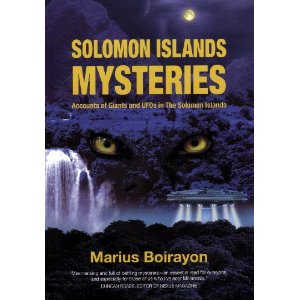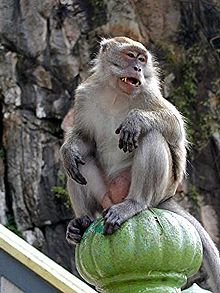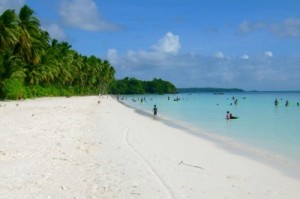World War II Cryptids Of The Pacific
Posted by: mystery_man on October 27th, 2012
During the course of World War II, Japanese forces were spread out to far flung islands throughout the Pacific theater. These operations often threw the soldiers into strange lands, where they were faced with new cultures and mysteries they could not fathom. These remote, exotic new locales occasionally presented ethnoknown creatures that had previously been unknown to the outside world.
Let us take a crypto tour of some of these cryptozoological mysteries. Here is a round up of just a few of the creatures encountered by Japanese soldiers during the Pacific War.
Solomon Island True Giants
The Solomon Islands are an island chain east of Papua New Guinea that is comprised of nearly 1,000 individual islands. These islands experienced some of the fiercest fighting in World War II, and are most famous for the bloody Battle of Guadalcanal.
Japanese soldiers had more to contend with than allied soldiers on the Solomon islands. While traversing the islands’ numerous remote, thick rain forests, the soldiers often reported coming across giant, hairy hominids ranging from 10 to 15 feet in height. In many instances, these were not fleeting glimpses of the creatures either, as some units reported the giants as being quite aggressive and even attacking on occasion.
A giant confronting Japanese soldiers in the Solomon islands
Indeed, the Solomon Islands have a long history of mysterious giants, and the local people are well aware of them. There is a rich tradition of folklore, as well as sightings and footprint evidence of giant hairy hominids on the islands that continue right up to the present day.
These creatures are described as being commonly around 10 feet tall, but as large as 15 feet tall. They are said to be covered in long, brown to reddish brown hair, with prominent brows, flat noses, and wide mouths.
A good resource for more information on these giants is the book Solomon Island Mysteries, by Marius Boirayon. You can also read more about these mysterious giants on Cryptomundo here.
Bukit Timah Monkey Man
The Bukit Timah Monkey Man is a hairy hominid or some sort of primate said to inhabit Singapore, primarily the Bukit Timah rainforest region. This cryptid is largely known through accounts from Japanese soldiers in World War II, who often encountered the creatures during the Japanese occupation of Singapore.
This cryptid is said to be a bipedal, ape-like creature, around 3 to 6 feet tall, and covered with grayish hair.
Although most accounts date from World War II, occasional sightings of these creatures persist into the present day. All sightings have occurred within the confines of the The Bukit Timah Nature Reserve, which is a protected area that is the only remaining primary forest in Singapore.
The reserve was established in 1883, and has remained largely undisturbed and unspoiled for hundreds of years. The reserve only has an area of 1.64 square kilometers, yet has amazing biodiversity. It is said that 40% of Singapore’s flora and fauna is found here. Tigers were found on the reserve until the end of the 19th century.
The Bukit Timah Nature Reserve
It seems odd that a cryptid as large as the Monkey Man could remain undiscovered in such a small land area, regardless of how pristine or heavily forested it is. In addition, the reserve sits just 12 kilometers from the city center, and in modern times is surrounded on all sides by urban development.
It is often pointed out that hairy hominid reports are the result of misidentifications of crab-eating macaques (Macaca fascicularis), which are common to the area.
Crab-eating macaque
Giant Land Crabs
Japanese soldiers in World War II encountered curiosities in isolated areas of their own homeland as well.
Soldiers stationed on remote islands of the Japanese archipelago, particularly in the Ryukyu island chain, were occasionally startled by giant crabs roaming around on beaches and in coastal forests. The crabs were described as being like large spiders, with long, spindly legs and small bodies.
One horrifying account allegedly occurred in the aftermath of The Battle of Okinawa, a battle that was fought over 82 days in 1945 and is considered to be the largest amphibious assault in the Pacific War. A Japanese unit came across a large number of what they described as huge, spider-like crabs feeding on the dead bodies of fallen soldiers on the beach. The crabs in this case were said to have leg spans ranging from 2 to 4 meters.
It is generally thought that these accounts are the result of sighting giant Japanese spider crabs that had somehow wandered up onto land. Some of the soldiers themselves described them as such. Japanese spider crabs inhabit the waters of Japan and have the longest leg spans of any arthropod, up to 3.8 meters (12 feet). As their name suggests, they look very much like large, long legged spiders. These creatures would certainly be a chilling and surprising sight on land.
Japanese spider crab
There are several problems with this species as an explanation for accounts of giant land crabs, though. First, although spider crabs have been known to come into shallower waters from time to time, adult crabs are usually found at depths of 50 to 600 meters (160 to 2,000 feet). In addition, it seems unlikely that these crabs would be able to function on land to any appreciable degree. Arthropods have exoskeletons, skeletons on the outside of their bodies as opposed to humans, with endoskeletons.
This creates the problem of the weight of this exoskeleton when scaled to large sizes. Muscle strength is largely a factor of the muscle at its widest point, so as the crab grows, its muscle with regards to strength grows in two dimensions as the exoskeleton grows in three dimensions. Simply put, at such large sizes, the exoskeleton would simply become too heavy for the crab to carry on land. These crabs can get so large precisely because they live underwater, where the water can support the weight of their exoskeletons.
To be sure, there are large species of land crab, such as the coconut crab which is the largest terrestrial arthropod. However, these crabs are more robust than spider crabs and have adapted to life on land such as evolving an organ called a branchiostegal lung, which is a sort of cross between gills and lungs.
coconut crab
Japanese spider crabs have no such adaptations, and with such long legs spans, it seems unlikely that they would be able to effectively function on land, if at all. I remain doubtful that Japanese soldiers would have seen spider crabs lurking and scurrying about on land in coastal areas. Perhaps something more like a coconut crab or some unknown terrestrial arthropod was behind the reports.
Whatever they were seeing remains mysterious.
The Orang Ikan
A Japanese surveillance team stationed on the picturesque Kei Islands, also known as the Kai Islands, of Indonesia reported coming across strange merbeings described as being around 150cm tall, with two arms and legs ending in webbed hands and feet, and carp-like mouths filled with spiny teeth. The heads were adorned with prominent spines and the faces were somewhat human-like in appearance.
The Kei islands
Baffled soldiers sometimes encountered these curious beasts frolicking and splashing about in the water as well as occasionally even coming up on beaches. The native population of the islands knew of these creatures and called them the Orang Ikan, or “man fish.”
When one was found dead on a beach, the locals invited the sargeant of the team, Taro Horibe, to come look at the body in the village chief’s house. Horibe described the dead creature as being around 160 cm long and possessing a head of red-brown, shoulder length hair, and spines along the neck. The face was said to be quite ugly, with human-like and ape-like features; a low, short nose, a broad forehead, and small ears. The lipless mouth was wide like that of a fish, specifically described like that of a carp, and filled with tiny, needle-like teeth. The creature’s fingers and toes were long and webbed. Horiba also reported that there was some sort of algae attached all over its body.
With no evidence of his encounter, Horibe was unsuccessful in getting zoologists from his home country to investigate upon his return.
You can read my full report on the Orang Ikan here.
Kai Islands
The unfortunate aspect of all such war time cryptid reports is that they were made by soldiers, often under situations of high stress and duress. This could have contributed to misidentifications, mistakes, elaboration, or even pure fabrication. It is hard to say just how such wartime stress could have colored eyewitness accounts.
What’s more, since the cryptids were encountered during wartime, there was rarely any attempt to collect evidence or launch a proper investigation into these bizarre occurrences. These were soldiers, there to fight, not scientists or trained zoologists. In most cases these cryptid reports were considered anomalies and distractions from what the eyewitnesses’ primary objective was, which was to wage war. In addition, few scientists would have been willing to go back and venture into these war zones to investigate such reports even if they were so inclined.
In closing, considering the circumstances it is understandable that little to no follow up was ever properly done in these World War II cases. However it also means that many such accounts are lost to time, and that we may never know the answers to these mysteries.
About mystery_man



















mystery_man: cool blog.
One thing worth keeping in mind with regard to “mythical” beasts: myths tend to be culture-specific and not jump cultures. (A major problem with chalking up the sasquatch and yeti, for example, to “native legends.”)
That is, er, a normal size big garbage can, right? If so that is NOT a normal-size crab!
My routine way of treating anything like this: suspended judgment. We have been shocked more than often enough that I consider a cynical take on stuff like this a marker that the person may not know that much about the natural world.
I have personally seen a coconut crab with a leg span of over 3 feet on Saipan. They look like a nightmare cross between a tarantula and a lobster. Very tasty and highly sought after, so you rarely see them that big any more… my local islander buddies tell me they can get quite a bit larger than that even, especially on the remote Northern Islands. Looks to be a very large female in the picture (males are generally smaller and not as fat in the body) maybe in excess of 4 feet leg span… probably a 30 gal garbage can. You can tell it’s one of the bigger ones, smaller specimens have longer legs in proportion to their body.
Interesting topic Mystery Man… maybe German U-boat logs might also make some mention of Pacific cryptids. It occurred to me because Germans traditionally keep good records of things, whereas Japanese have a tendency to sweep things under the rug if they think them embarrassing or irrelevant.
Alamo: funny you should mention Germans and records of things, given this.
Very interesting DWA… It gave me a thought, perhaps Stellar’s Sea Ape and Orang Ikan could be related? There’s quite a bit of support for the Aquatic Ape theory of human development. Here’s a pretty good summation.
I first heard of the concept in Lyall Watson’s ‘Dreams of Dragons’. Some basic points:
1. Our dive reflex
2. Webbed hands & feet
3. Lack of body hair, detrimental in a terrestrial ape… but well suited to an aquatic one
4. Our bipedal stance (a result of keeping our head up during forays into deeper water)
5. Our big brain (extra cells developed to compensate for those succumbing to anoxia during diving)
6. (This one is my own) As any dieter knows, fat is the last thing to come off… anaerobic activity will cause muscle tissues to break down before fat. Why is preserving fat so important to our body, so much so that we’ll eat our muscles before utilizing fat reserves? Maybe because we needed it for buoyancy…
Could the Sea Ape and Orang Ikan be offshoots of a common aquatic ancestor?
The Bukit Timah Monkey Man is my favourite cryptid because we share the same country! I believe that it may be nocturnal as most sightings occur at night or early in the morning. Though it is true that the crab-eating macaque is common in the Bukit Timah Nature Reserve, descriptions of the Monkey Man show that it is much larger, ranging from 1-2m tall whilst the common crab-eating macaque is only about 38-55cm tall when standing on its hind legs. It can’t be a bear or ape as there are no bears or apes in the area. It may in fact be closely related to other cryptids like the Orang Pendek or the Monkey Man of New Delhi.